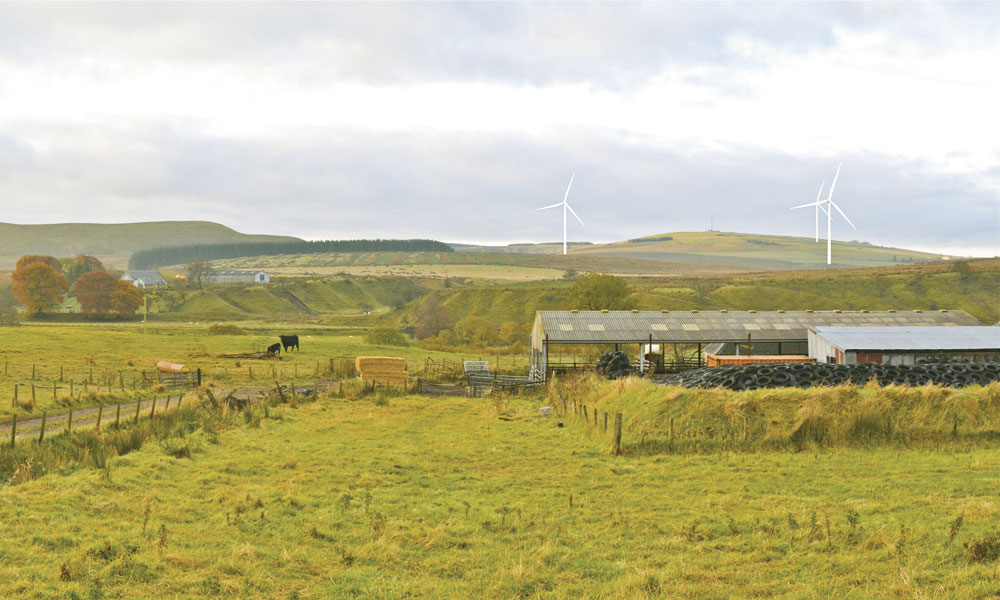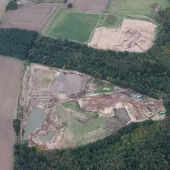Energy for Minerals

To remain competitive and become increasingly sustainable, the minerals sector must address its energy consumption and supply. Adrian Lea, technical director with Wardell Armstrong, outlines some opportunities for renewable energy technologies at mineral sites.
The extraction, processing and transportation of minerals have generally always been energy-intensive activities, with each being vulnerable to rising energy costs. The cost of energy is now, arguably, the most expensive part of any mineral activity, and energy prices are set to increase further as a result of a diminishing domestic supply and increasing reliance on imports.
If the minerals sector is to remain competitive, and become increasingly sustainable, it must address its energy consumption and supply – and there appears to be plenty of opportunity in this area. Energy reduction and efficiency are central to sustainability and lie at the top of the ‘energy hierarchy’. It is always much cheaper, and more sustainable, to conserve or avoid wasting energy than to build new energy-generating capacity to cover unnecessary consumption or cost. These saved units are often referred to as ‘negawatts’. The use of renewable energy technologies, such as wind or solar power, is next on the energy hierarchy, followed by the use of energy generated using low-carbon technologies.
Britain has a target to produce 15% of its energy, including electricity, heat and transport, from renewable sources by 2020 in a bid to cut climate-warming emissions. This means that 30% of the country’s electricity must come from renewable sources by the end of the current decade. A host of financial measures, such as the Feed in Tariff (FiT) and the Renewable Obligation Certificates (ROC), have been introduced to incentivize the development of a range of renewable energy technologies.
The aim is that renewable energy technologies should become more competitive over time as all sources of electricity, especially imports, become more expensive. Eventually, it is hoped that ‘grid parity’ – the point at which an energy source becomes a contender for widespread development without subsidies or government support – will be achieved. It is widely believed that a wholesale shift in generation to these forms of renewable energy will take place when such grid parity is reached.
Legislative measures such as the Carbon Reduction Commitment Energy Efficiency Scheme (CRC) have also been introduced. The CRC is a new mandatory emissions-trading scheme that aims to reduce the amount of carbon dioxide (CO2) emitted in the UK. This is vital to achieving the UK’s overall target of reducing greenhouse gas emissions by at least 80% by 2050, compared with the 1990 baseline. Organizations that meet the CRC qualification criteria, which are based on how much electricity they consumed in 2008, will be obliged to participate in the scheme. Those organizations with an annual electricity demand of more than 6,000MWh, estimated to be around 5,000 organizations, will be required to participate fully in the scheme. This means they must not only record and monitor their CO2 emissions, but also purchase allowances.
Wind power
The minerals sector is well placed to meet many of these challenges. The UK has the best wind resource in Europe and at the beginning of 2013 had installed wind turbines with a total capacity of approximately 8,500MW. It is estimated, however, that the total installed wind capacity in 2020 could be as high as 28,000MW. Mineral operations often cover large areas of land and are located some distance from ‘sensitive receptors’, such as housing, where temporary development such as the installation of wind turbines or solar panels may be compatible with the life of mineral operations. Such sites often also have a good connection to the electricity grid and can be in exposed locations with an excellent wind resource. The ability of the local highway network and the site itself to accommodate large plant and machinery, in particular the lengthy components of a wind turbine, is a critical requirement.
A large wind turbine will require extensive foundations and ground stability can, therefore, also be a critical issue, although the minerals sector is often well placed to develop and engineer the required foundations. The nature of the local topography and landscape is also important; there should be an absence of structures or obstructions, such as buildings, vegetation or contours, which may cause turbulence or impede the efficient operation of the wind turbine.
The landscape and visual impact of a proposed wind turbine, particularly within a sensitive or designated landscape such as a national park or an Area of Outstanding Natural Beauty, will also require very careful consideration. Wind turbines are often the tallest structures in the local landscape and the need to locate them with unimpeded access to the wind resource means that they can often be very prominent. These are often some of the most critical issues when considering the installation of a wind turbine – although other issues, such as ecology, radar, grid connection and telecommunications, mean that specialist technical advice should be sought at the initial site-assessment and feasibility stages.
Solar power
Solar irradiation (or sunlight) levels in the UK are very similar to those experienced in Germany. However, with nearly 33GW of installed solar photo-voltaic (PV) capacity, Germany has nearly half of the installed European solar PV capacity, far exceeding Italy (16GW) or Spain (4.5GW) and certainly the UK (1.66GW). The high rate of installation in Germany has stemmed from continued government support, and has also resulted in Germany becoming the major European manufacturer of solar panels.
Nevertheless, solar PV is also becoming increasingly popular in the UK where large numbers of ground-mounted solar panels, or solar farms, have been developed in recent years. Such ground-mounted solar panels may be appropriate at mineral sites in areas where quarrying activity has either been completed or is not scheduled to take place for many years. It may also be possible to re-profile or contour restored mineral sites to achieve a gradual south-facing slope, in order to facilitate, and optimize the efficiency of any future ground-mounted solar PV installation.
The first solar farm to be granted planning permission in the UK is located at the former Wheal Jane mine site, near Truro, in Cornwall. This 1.4MW solar farm, containing nearly 6,000 solar panels, generates 1,437MWh of electricity a year – enough to meet the electricity demands of 430 local homes – and is an excellent example of what can be achieved at a former mineral site.
Many mineral sites also have large buildings with significant potential for the installation of roof-mounted solar PV, although consideration should be given to factors such as orientation, profile and structural suitability. In some instances, permitted development rights may exist for the installation of solar panels on existing roofs at mineral sites. Where large buildings are planned, it is recommended that such buildings are sited, designed and built in a manner which facilitates, and does not preclude, the future installation of a roof-mounted solar array, even if the array is not to be installed immediately.
Hydro-electric power
Hydro-electricity is a widely utilized renewable energy technology, producing more than 15% of global electricity generation, and has the benefit of producing consistent, or baseload, electricity, often utilizing a retaining dam in a watercourse. Such retaining dams can be problematic, disrupting fish movements and acting as a potential obstruction to water flow, thereby increasing flood risk. A pumped storage scheme utilizing two water bodies at different elevations offers an alternative method of hydro-electricity generation.
A pumped storage scheme allows water to be pumped to, and stored in, the higher water body. The water is released at times of high electricity demand, passing through turbines and thereby generating electricity before entering the lower water body. The water can be pumped back up to the higher water body when the availability or cost of electricity is favourable with minimal impact on ecology or risk of flooding. Such a ‘closed-loop’ pumped storage scheme can assist the balancing or management of the electricity grid, using surplus electricity at times of excess capacity and generating electricity to meet peak demand.
The largest pumped storage scheme in the UK is at Dinorwic, in North Wales, where 12 million tonnes of rock were removed from the former Dinorwic slate quarry to create a facility capable of reaching a 1,800MW generating load in approximately 16 seconds. Once running, the facility can provide power for up to six hours before the upper reservoir is exhausted. The facility is referred to as a ‘Short Term Operating Reserve’, acting in response to short-term rapid changes in power demand or sudden loss of power stations. The development of smaller pumped storage schemes may be possible in a number of former mineral sites throughout the UK. There is broad planning support for the delivery of electricity and/or heat generation in co-location with consumption.
Planning considerations
Although the above are the three main renewable energy technologies that are likely to be available, there is a significant variety of other technology types and sizes potentially available, and it is recommended, therefore, that expert advice is sought at an early stage. The National Planning Policy Framework, published by the Department for Communities and Local Government in March 2012, sets out the Government’s planning policies for England. The Framework consolidates more than two dozen previously published planning policy and guidance documents and emphasizes the presumption in favour of sustainable development. The Framework states that ‘local planning authorities should recognize the responsibility on all communities to contribute to energy generation from renewable or low-carbon sources’. This includes identifying ‘opportunities where development can draw its energy supply from decentralized, renewable or low-carbon energy supply systems and for co-locating potential heat customers and suppliers’.
It would appear that there is now increasing awareness of, and support for, the decentralized generation of electricity where grid losses can be minimized and industry is allowed to become increasingly sustainable and cost-effective. The minerals industry is well placed to take advantage of this opportunity and should strongly consider the renewable energy resource available within its property portfolio.
The planning system, while greatly supporting sustainable development, now also encourages and promotes engagement with local communities. Developers are increasingly encouraged to consult and engage with local communities at a very early stage and certainly before any planning application is submitted to the local planning authority. The views and representations of the local community at this initial consultation should be recorded and any mitigation or enhancement measures proposed or suggested should, ideally, be accommodated before a second community consultation is undertaken prior to the submission of a formal planning application.
The aim is to engage and inform the local community, raise awareness and understanding, and, hopefully, increase the acceptability of any development proposal, thereby increasing the success rate of such proposals as part of the Government’s ‘localism’ agenda. A high level of community engagement is certainly expected by planning inspectors when considering any appeal against decisions made by local planning authorities. Developers are, therefore, urged to undertake early engagement with local communities and record the attendance/views received and any mitigation measures proposed. In this way, it is hoped that the UK’s renewable energy generating capacity can be increased and the minerals sector can become increasingly sustainable and cost-effective.
About the author: Adrian Lea is a Fellow of the Institute of Quarrying and a Member of the Royal Town Planning Institute. He was previously manager of the Natural Resources Planning Team at Cornwall Council until recently joining Wardell Armstrong as a technical director.




